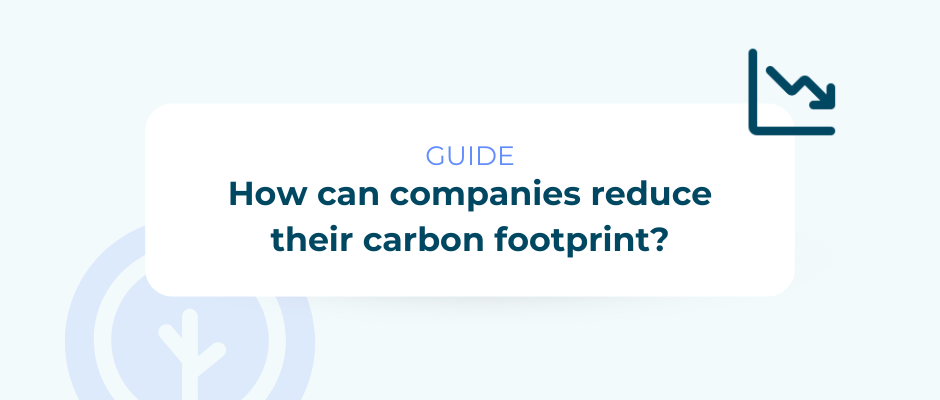How can companies reduce their carbon footprint: a practical guide
Reading time: 7 minutes
Reading time: 7 minutes

As a company, you may be asking: how can companies reduce their carbon footprint?
Tackling this question matters. From Scope 1 and 2 emissions in your operations, to Scope 3 emissions across supply chains, each step offers powerful opportunities to cut greenhouse gas emissions, comply with regulations, and boost competitiveness.
In this guide, we walk you through a structured, step‑by‑step approach. We begin with how to measure your baseline emissions, then set science‑based targets and implement a climate transition action plan. You’ll learn how to boost energy efficiency, switch to renewable energy, adopt sustainable procurement, reduce travel emissions, and embrace circular economy practices. We’ll also cover how to engage employees, secure financing, and monitor progress over time.
By the end, you’ll have a clear roadmap to reduce your carbon footprint and accelerate your decarbonisation journey.
Understanding how companies reduce their carbon footprint begins with calculating their carbon footprint. You need to measure emissions across:
Adopt a structured carbon accounting method, such as the GHG Protocol. Use a carbon management software to centralise data from invoices, utility bills, and supplier questionnaires. If data is incomplete, use conservative estimates and improve over time.
Baselining your operations allows you to track progress and benchmark against peers. Scope 3 can account for up to 90% of total emissions in many companies—meaning supplier engagement and procurement changes are essential.
Once you have a baseline, set science‑based targets that align with limiting global warming to 1.5 °C. These should be specific, measurable, achievable, relevant, and time‑bound (SMART):
Targets are most effective when linked to decision‑making at every level, from procurement to HR policy.
Upgrading facilities can deliver immediate carbon and cost reductions.
Energy efficiency measures often have a payback period of 2–5 years and reduce emissions and utility bills.
Transitioning to renewable energy can drastically reduce Scope 2 emissions.
When possible, align contract terms with your target dates to ensure long‑term decarbonisation consistency.
Transport policies can cut a significant portion of operational emissions.
These measures reduce emissions, cut costs, and improve employee well‑being.
Engaging suppliers is essential for Scope 3 reductions.
This fosters shared responsibility and builds stronger, more sustainable business relationships.
Circular economy principles minimise emissions from material use and waste.
Reducing waste at source is usually more cost‑effective than managing waste after it’s created.
IT operations can consume more energy than expected—especially with increased cloud usage.
Even small IT changes can yield measurable carbon and cost savings at scale.
Behavioural change is critical to long‑term success.
A workforce that understands and supports sustainability goals is more likely to innovate and maintain momentum.
Regular monitoring ensures progress stays on track.
Transparency builds trust with customers, investors, and regulators.
Even after maximising internal reductions, most companies will have some unavoidable emissions—at least in the short term. Carbon contributions (often called carbon compensations or offsets) involve funding external projects that remove or avoid greenhouse gas emissions, such as renewable energy installations or reforestation.
Pros:
Cons:
When to use:
Carbon contributions should only be used for residual emissions that cannot yet be eliminated, and always in parallel with a robust reduction strategy. Prioritise high‑quality, certified projects that are transparent about impact and monitored over the long term. Contributions are not a substitute for decarbonisation but a complementary step in a credible climate strategy.
Reducing a company’s carbon footprint is essential and achievable with a structured approach. For businesses in Belgium, France, the Netherlands, Luxembourg, and the UK, the journey starts with measuring Scope 1, Scope 2, and Scope 3 emissions. From there, science‑based targets will be set, and a Climate Transition Action Plan will be developed to embed decarbonisation into every department.
Focus on quick wins—energy efficiency upgrades, renewable energy sourcing, and sustainable mobility policies—while building long‑term capacity in supply chain engagement, circular economy practices, and green IT. Keep employees involved, secure funding to scale your projects, and track progress with robust reporting systems.
When unavoidable emissions remain, consider high‑quality carbon contributions as a short‑term complement to your reduction efforts. This balanced approach delivers measurable environmental benefits, ensures regulatory compliance, and strengthens stakeholder trust—helping your business thrive in a low‑carbon economy.